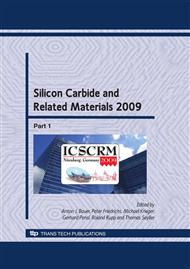p.987
p.991
p.995
p.999
p.1005
p.1009
p.1013
p.1017
p.1021
Comparison of Inversion Layer Electron Transport of Lightly Doped 4H and 6H SiC MOSFETs
Abstract:
nversion layers of 4H and 6H Silicon carbide based MOS devices are characterized by Gated Hall measurements to determine the trap density close to the conduction band edge and the main scattering mechanisms that limit the mobility. MOS gated Hall structures were fabricated on 4H SiC polytype with p-type doping of 5X1015cm-3 and 2X1017cm-3. MOS Gated Hall structures were also fabricated on 6H SiC polytype with p-type doping of 7.5X1015cm-3. The gate oxide was grown thermally with N2O as a precursor followed by a NO post oxidation anneal. The inversion layer Hall mobility on the 6H SiC MOSFET sample decreased with increasing temperature from room temperature to 423K, while on the 4H SiC MOSFET samples the inversion layer mobility increased slowly. Approximately 50% of the total charge density at the interface of both 6H and 4H SiC MOSFETs was found to be trapped charge. The dominant scattering mechanism in 6H SiC MOSFETs was inferred to be phonon scattering based on the temperature dependence and theoretical estimates of the phonon limited mobility. In the case of 4H SiC, we infer that at surface roughness scattering is the dominant scattering mechanisms at high surface fields.
Info:
Periodical:
Pages:
1005-1008
Citation:
Online since:
April 2010
Authors:
Keywords:
Price:
Сopyright:
© 2010 Trans Tech Publications Ltd. All Rights Reserved
Share:
Citation:


